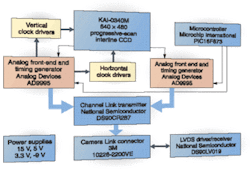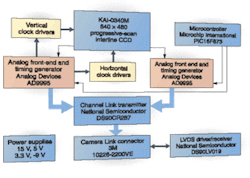Camera design targets vision and security
Designers of CCD cameras for the machine-vision and security markets can now develop their products more rapidly, thanks to a compact demonstration unit (CDU) from Kodak's Image Sensor Solutions Group (Rochester, NY, USA; www.kodak.com/ go/imagers). Developed specifically for the company's KAI-0340M interline CCD, the CDU offers a reference design that targets both markets using readily available off-the-shelf ICs. The Kodak KAI-0340 Image Sensor is a 640 × 480-pixel, 1/3-in. optical-format, progressive-scan interline CCD that is offered in two versions.
While the dual-tap KAI-0340DM supports 210 frames/s, the single-tap KAI-0340SM runs at 110 frames/s. For machine-vision applications, camera designers can take advantage of the device's fast horizontal line dump to clock the device at rates as high as 3500 frames/s. For color imaging applications, both versions can also be supplied with Kodak's RGB Bayer color-filter array.
To aid in sensor evaluation and camera development, Kodak recognized the primary markets for the device were in machine-vision and security applications. "In the security market," says Terry Guy, product marketing manager at Kodak, "the aim was to produce a reference design that could be implemented at volumes of 25,000 with a bill of materials of less than $100."
In such applications, there is no need to use the second tap of the camera, since 30 frames/s at 640 × 480 is sufficient to meet performance requirements. "However," says Guy, "in machine-vision applications, camera vendors may wish to run at frame rates of 210 frames/s or faster." Because of this, the CDU reference design needed to accommodate a means of incorporating both applications.
Kodak's Systems Engineering group developed a compact camera that accepts monochrome or color versions of either the single- or dual-tap KAI-0340M. In the design of the 2 1/2-in. square PCB, it was necessary to generate the correct timing for the CCD sensor, perform analog-to-digital conversion, as well as offer correlated double sampling (CDS) to improve the signal-to-noise ratio of the image sensor.
"By subtracting a pixel's dark or reference output level from the light-induced signal, static fixed pattern noise and temporal noise can be removed from the sensor's output," says John Compton, head of the Systems Engineering Group. Luckily, all these features are offered in the AD9995, a 12-bit CCD analog front end (AFE) from Analog Devices (Norwood, MA, USA; www.analog.com). "One AFE is used to provide the timing generation for Kodak's own vertical and horizontal clock drivers and at the same time provide CDS and 12-bit digital output from a single tap of the KAI-03040M," says Compton. Although a second AFE is used to provide CDS and 12-bit output from the second tap of the CCD, it was not necessary to use the timing generation circuitry of the device.
"We chose to use two of the same AFEs in the design so that the electrical output parameters of the devices would match," says Compton. Frame sync, line sync, and 12-bit data from the first AFE (shown left in the figure) and 12-bit data from the second AFE are then input to a DS90CR287 from National Semiconductor (Santa Clara, CA, USA; www.national.com). This transmitter accepts LVTTL/LVCMOS data signals from both the AFEs and the frame and line sync information. The LVDS transmitter then converts the LVTTL/LVCMOS parallel lines into four serialized LVDS data pairs and a LVDS clock pair that can be directly interfaced to the 10226-2200VE Camera Link connector from 3M (St. Paul, MN, USA; www.3m.com).
For overall control of the CDU design, the PIC16F873 from Microchip (Chandler, AZ, USA; www.microchip.com), an 8-bit CMOS FLASH microcontroller, is used to program both the AFEs through a three-wire serial interface. "Because the serial-interface timing requirements for the AFEs are broad," says Compton, "it was a fairly easy task to write software to clock the AFEs at the appropriate time." Because the CDU is based on the Camera Link interface, it was necessary to provide a bidirectional serial interface from the PIC to the Camera Link connector. This was accomplished using another National Semiconductor part, a DS90LV019 LVDS driver receiver.
This serial interface allows commands to be sent from an external PC over the Camera Link interface to directly program the PIC and thus the operation of the image sensor. According to Terry Guy, the CDU will not be offered as a standard product by Kodak. However, the company is supplying the reference design free of charge to CCD camera developers.
To demonstrate the unit, Kodak has interfaced the board with laptop PCs using the iPort Camera Link-to-Gigabit Ethernet engine from Pleora (Ottawa, ON, Canada; www.pleora.com). Windows 2k/XP OS-based software from Kodak can then be used to reconfigure the CDU for a number of monochrome and color versions of the KAI-0340 in different modes and at different data rates.

